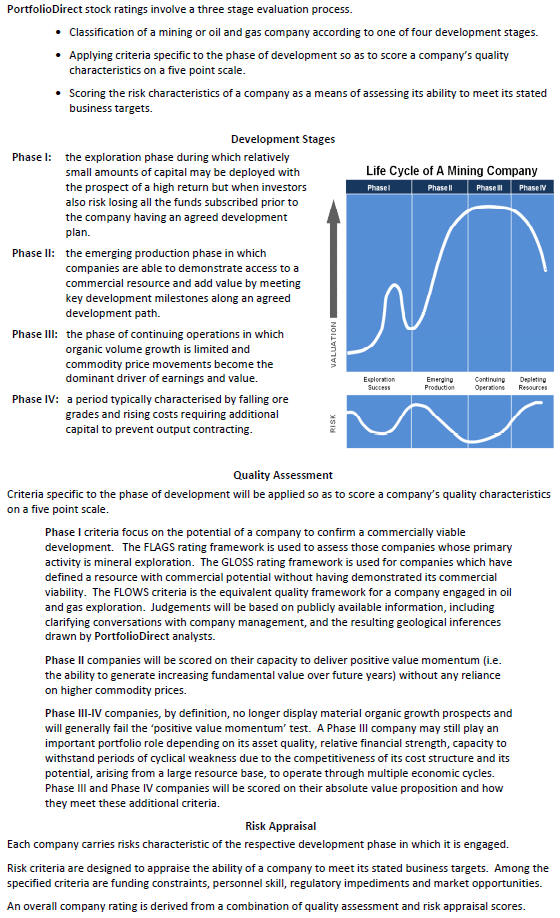
-
About
PortfolioDirect -
Subscription
Information

Ratings and Investment Outcomes
Ratings are not intended as short term share price predictors. The primary purpose of a rating is to assess the extent to which companies may meet and possibly exceed market expectations about their business outcomes.
The ratings are intended to point to those companies which, over time, are most capable of building underlying value through their projects or primary development assets.
In the short term, market returns may vary due to factors other than those taken into account in formulating the PortfolioDirect ratings.
A company with a low rating may achieve better investment returns than a company with a higher rating. Among the reasons a company may receive a low rating are inadequate funding, operational shortcomings or generally inferior exploration interests. Companies in such positions can display very strong share price leverage to a change in their circumstances.
Rating reviews will often highlight where a change in circumstance could occur but a low rating is intended to signal that such changes, although possible, are uncertain or so ill-defined as to warrant significant investor caution.
Companies already in production are rated against their ability to sustain value building activities without having to rely on favourable changes in the macro environment in which they operate.
Individual stock ratings do not anticipate changes in the macroeconomic or policy environment unless such a change is specific to an individual company. Changes in the macroeconomic conditions in which the companies operate and their implications for stock selection and portfolio construction are addressed separately within the PortfolioDirect analytical framework.
Significant Investment Risks
In addition to general equity market risks reflecting unexpected changes in global economic or political conditions, investors in the resources sector may incur further risks specific to investments in the sector.
Commodity market risk: Resources sector investment returns are generally more volatile than returns from other equity market sectors due to the earnings of resources companies being exposed to commodity price and foreign exchange movements. Commodity prices can be influenced by a range of factors including economic events, which might affect the volume of commodities used, monetary policies which might affect levels of speculation and changes in output reflecting levels of industry exploration, investment and production disruptions.
Operational risk: Companies may fail to meet their development goals as a result of unexpected external influences, including political conditions and natural phenomena, as well as the skill base and operational capabilities of company management. Companies engaged in exploration activities may fail to locate or define mineral deposits of a sufficient size to be commercially viable.
Funding risk: Since companies in the resources sector require ongoing funding for development, expansion and maintenance of output, changes in financial market conditions can affect the value of investments adversely through the cost or availability of capital.
Regulatory risk: The value of investments in the sector may be affected adversely by changes in government policies relating to the conditions under which mine developments are permitted, including the need for more stringent environmental controls, higher taxation or royalty rates or requirements for local equity participation.
Small companies risk: Small or early stage companies generally have less diversified income streams, less stable funding sources and weaker bargaining positions with their counterparties than larger companies. The securities of small companies may also be less liquid than those of larger companies making the purchase or sale of securities more difficult or costly to complete, possibly with an adverse impact on portfolio performance.